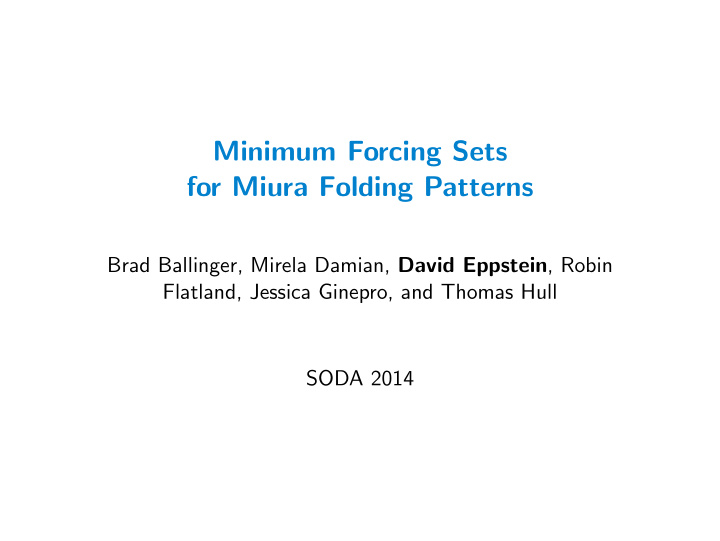



Minimum Forcing Sets for Miura Folding Patterns Brad Ballinger, Mirela Damian, David Eppstein , Robin Flatland, Jessica Ginepro, and Thomas Hull SODA 2014
The Miura fold Fold the plane into congruent parallelograms (with a careful choice of mountain and valley folds) Has a continuous folding motion from its unfolded state to a compact flat-folded shape CC-BY-NC image “Miura-Ori Perspective View” (tactom/299322554) by Tomohiro Tachi on Flickr
Applications of the Miura fold High-density batteries Paper maps http://www.extremetech.com/extreme/168288- http://theopencompany.net/products/ folded-paper-lithium-ion-battery-increases- san-francisco-map energy-density-by-14-times Satellite solar panels Acoustic architecture http://sat.aero.cst.nihon-u.ac.jp/ sprout-e/1-Mission-e.html Persimmon Hall, Meguro Community Campus
Self-folding devices http://newsoffice.mit.edu/2009/nano-origami-0224 Motorize some hinges Leave others free to fold as either mountain or valley
Our main question: How many motorized hinges do we need? GPL image SwarmRobot org.jpg by Sergey Kornienko from Wikimedia commons Optimal solution = minimum forcing set We solve this for the Miura fold and for all other folds with same pattern
Non-standard Miura folds To find minimum forcing sets for the Miura fold we need to understand the other folds that we want to prevent http://www.umass.edu/researchnext/feature/new-materials-origami-style E.g. easiest way to fold the Miura: accordion-fold a strip, zig-zag fold the strip, then reverse some of the folds Locally flat-foldable : creases in same position as Miura, and a neighborhood of each vertex can be folded flat
Bird’s foot theorem Describe folds by assignment of mountain fold or valley fold to each segment of the crease pattern Locally flat-foldable Miura ⇔ at each vertex, ◮ The three toes of the bird foot are not all folded the same ◮ The leg is folded the same as the majority of the toes Follows from Maekawa’s theorem ( | #Mountain − #Valley | = 2) together with the observation that the fold with three toes one way and the leg the other way doesn’t work
Locally flat-foldable Miura ≡ grid 3-coloring [Hull & Ginepro, J. Integer Seq. 2014] 0 1 0 1 2 2 1 2 0 0 0 1 0 1 2 Follow boustrophedon (alternating left-to-right then right-to-left) path through the pattern, coloring quads with numbers mod 3 Path crosses mountain fold ⇒ next color is +1 mod 3 Path crosses valley fold ⇒ next color is − 1 mod 3 Obeys bird’s foot theorem ⇔ proper 3-coloring
Forcing sets from domino tilings Forced crease ≡ fixed difference (mod 3) between colors in the two squares of a domino (rectangle covering two adjacent Miura quads) 0 1 0 1 2 2 1 2 0 0 0 1 0 1 2 For standard Miura , two-domino tiling of a 2 × 2 square fixes the color differences for the other two dominoes in the square All edges belong to some domino tiling, and all domino tilings are connected by 2 × 2 flips ⇒ every domino tiling is a forcing set But how good is it?
Grid 3-coloring ≡ Eulerian orientation 0 1 0 1 2 2 1 2 0 0 0 1 0 1 2 For each grid edge from color i to color i + 1 (mod 3) orient the crease segment that crosses it 90 ◦ clockwise (so when viewed from the cell with color i , it goes left-to-right) Form a directed graph with a vertex at each crease vertex (+one more vertex, attached to all creases that reach paper edge) Then at all vertices, indegree = outdegree
Recolorings and cycle reorientations If the directed graph has a cycle, we can add ± 1 (mod 3) to all colors inside it (reversing the orientation of the cycle edges) 0 1 0 1 0 1 0 0 1 0 1 0 1 0 1 0 1 2 1 0 1 1 0 2 0 1 0 1 0 1 0 2 0 1 0 0 1 2 1 2 1 0 1 1 2 2 1 0 2 0 1 1 0 0 0 1 0 1 0 1 0 1 0 0 1 0 1 0 1 0 1 0 1 0 1 0 1 1 0 1 0 1 0 1 For every two different grid colorings, the difference between them can be broken down into recoloring steps of this type
Forcing set ≡ feedback arc set Fixing the color difference of one grid edge prevents any recoloring step whose cycle crosses it 0 1 0 1 0 1 0 0 1 0 1 0 1 0 1 0 2 0 1 0 1 1 0 1 2 1 0 1 0 1 2 1 2 1 0 0 1 0 2 0 1 0 1 0 1 2 1 0 1 1 0 2 0 2 0 1 0 1 0 1 0 1 0 0 1 0 1 0 1 0 1 0 1 0 1 0 1 1 0 1 0 1 0 1 To prevent all recolorings, we must find a set of directed edges that intersect every cycle, force the crease type on those segments, and fix the color differences for the grid edges that cross them
What does this tell us about Miura forcing sets? Planar minimum feedback arc set solvable in polynomial time ⇒ We can compute minimum forcing set for any non-standard Miura Standard Miura ≡ checkerboard coloring ≡ orientation in which all quads are cyclically oriented ⇒ for every quad, at least one crease must be forced Basil Rathbone as Sherlock Holmes ⇒ domino tiling is optimal
Conclusions and open problems For the standard Miura with m × n quadrilaterals, � mn � optimal forcing set size = 2 Every non-standard Miura fold has smaller forcing sets (sometimes O ( √ mn )) that can be constructed in polynomial time What about optimal forcing CC-BY-SA image “elf” (origamijoel/1450169902) sets for other folding patterns? by Joel Cooper on Flickr
Recommend
More recommend